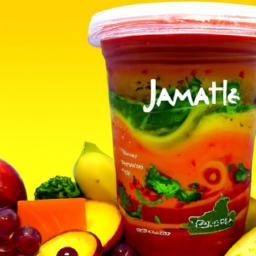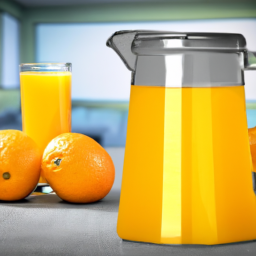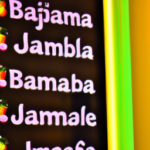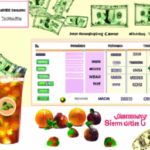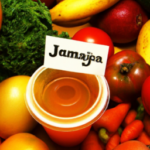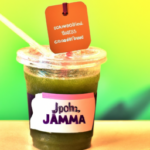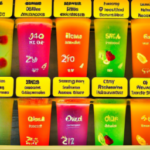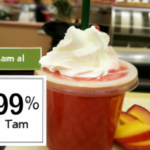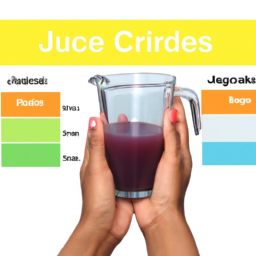As a fan of smoothies and juices, I am always on the lookout for new places to try. Jamba Juice is a popular chain known for its delicious and healthy drinks. But one question remains – how much does a medium-sized Jamba Juice cost?
In this article, I’ll explore the pricing of a medium Jamba Juice, as well as other important details like nutritional value, customization options, and loyalty programs.
First, let’s start with an overview of Jamba Juice. The company was founded in 1990 in California and has since expanded to over 800 locations in the United States and worldwide. They specialize in blended drinks made with real fruit and vegetables, as well as other healthy ingredients like almond milk and protein powder. Jamba Juice is committed to sustainability and offers many plant-based and low-sugar options for health-conscious consumers.
Now let’s dive into the specifics of a medium Jamba Juice.
Key Takeaways
- Jamba Juice is a popular chain specializing in blended drinks with real fruit and vegetables, with over 800 locations worldwide.
- A medium size Jamba Juice holds about 16 ounces and offers a wide variety of beverage options, including smoothies, juices, and bowls.
- Location-based pricing is common, and Jamba Juice offers discounts and promotions, as well as a loyalty program called Jamba Insider Rewards.
- Competitors such as Smoothie King and Robeks offer similar pricing strategies, with some charging more for organic ingredients and others offering discounts for loyalty programs or bulk purchases. Consumers are willing to pay a premium for quality and taste, with personal taste and preference being important factors.
Overview of Jamba Juice
You’re probably wondering what Jamba Juice is all about and why you should give it a try. Well, Jamba Juice is a wildly popular chain of smoothie and juice bars that has been serving up delicious and healthy beverages since 1990.
The first Jamba Juice was opened in San Luis Obispo, California, by Kirk Perron, and it quickly gained a following for its fresh ingredients and tasty blends. Since then, Jamba Juice has expanded to over 850 locations in the United States, with additional stores in Canada, Mexico, and the Philippines.
The history of Jamba Juice is fascinating, as it has gone through several name changes and ownership transitions over the years. However, its mission has always remained the same: to provide customers with healthy and tasty beverages that are made with real fruits and vegetables.
Jamba Juice has big expansion plans for the future, as it aims to open 1,000 locations worldwide by 2025. With its commitment to quality ingredients and sustainable practices, Jamba Juice is a great choice for anyone looking for a delicious and nutritious drink.
Now, let’s dive into what a medium Jamba Juice is all about.
What is a Medium Jamba Juice
When I walk into Jamba Juice, I always order a medium-sized drink. A medium Jamba Juice typically holds about 16 ounces of liquid, making it the perfect size for me.
In terms of the types of beverages available, Jamba Juice offers a wide variety of smoothies, juices, and bowls to choose from.
Size and volume
If you’re looking for a refreshing drink, a medium Jamba Juice is the perfect size to quench your thirst without feeling too full. The size of a medium Jamba Juice varies by location, but it typically contains 16 to 24 ounces of blended fruits and vegetables.
The ingredients used in a medium Jamba Juice vary depending on the flavor, but they typically include fresh or frozen fruit, fruit juice, and sometimes yogurt or vegetables. Serving suggestions for a medium Jamba Juice include adding boosts such as protein, immunity, or energy to enhance the nutritional value of the drink.
It’s also recommended to consume a medium Jamba Juice as a meal replacement or as a snack to promote healthy eating habits. With a variety of flavors and nutritional options, a medium Jamba Juice is a versatile and convenient choice for those looking for a refreshing and healthy beverage.
When it comes to types of beverages available, Jamba Juice offers a wide range of options including smoothies, juices, and bowls.
Types of beverages available
Explore the refreshing world of blended fruits, vegetables, and boosts at Jamba Juice, where every sip takes you on a flavorful journey of health and wellness. Jamba Juice offers an extensive variety of beverage options to cater to different tastes and dietary needs. Whether you’re in the mood for a fruity smoothie or a protein-packed drink, Jamba Juice has got you covered.
Here are some of the flavor options and nutritional information for some of the beverages available at Jamba Juice:
-
Classic Smoothies: These smoothies are made from a blend of fruits, juices, and nonfat yogurt. They are low in fat and high in vitamin C, making them a great option for a healthy and refreshing snack.
-
Fruit & Veggie Smoothies: These smoothies are a great way to get your daily dose of fruits and vegetables. They are made from a blend of whole fruits, vegetables, and juices, and are high in fiber and vitamins.
-
Protein Smoothies: These smoothies are perfect for gym-goers and fitness enthusiasts. They are made from a blend of fruits, protein powder, and nonfat yogurt, and are high in protein and low in fat.
-
Freshly Squeezed Juices: Jamba Juice also offers a range of freshly squeezed juices that are high in vitamins and minerals. They are made with whole fruits and vegetables, and are a great option for a quick and healthy breakfast.
Now that you know more about the types of beverages available at Jamba Juice, let’s move on to the pricing of a medium Jamba Juice.
Pricing of a Medium Jamba Juice
As someone who enjoys a good Jamba Juice from time to time, I’ve noticed that the pricing for a medium-sized drink can vary depending on the location.
I’ve seen prices range from around $4 to $6, which can make a difference in the long run if you’re a frequent customer.
Additionally, Jamba Juice often offers discounts and promotions, such as their rewards program or limited-time deals, which can also affect the price you pay.
Variations in pricing based on location
Interestingly, the price of a medium Jamba Juice can vary by up to $1.50 depending on the location. Location-based pricing is a common practice in the food and beverage industry, and Jamba Juice is no exception. The factors affecting pricing include the cost of living, competition, and demand in the area.
For instance, a medium Jamba Juice in a busy city center is likely to be more expensive than one in a suburban area with fewer customers. Additionally, the cost of ingredients and labor may vary depending on the location, which can also impact the final price of a Jamba Juice.
It’s important to note that the variation in pricing doesn’t necessarily mean that one location is charging more than another. Instead, it reflects the unique circumstances surrounding each location. As a Jamba Juice customer, it’s essential to be aware of the pricing differences and plan accordingly, especially if you’re on a budget.
In the next section, we’ll explore how you can save money on Jamba Juice through discounts and promotions.
Discounts and promotions
Looking to save some cash on your favorite Jamba smoothie? Check out the discounts and promotions available to you! Jamba Juice offers a variety of special offers and loyalty rewards to help you get the most bang for your buck.
Some of these promotions include a free smoothie on your birthday, discounts for students and military personnel, and even rewards for frequent purchases through the Jamba Insider Rewards program. If you’re a regular Jamba Juice customer, signing up for the Jamba Insider Rewards program can be a great way to save money on your purchases.
With this program, you can earn points for every purchase you make and then redeem those points for discounts on future orders. Additionally, Jamba Juice often runs seasonal promotions, such as discounts on specific menu items or limited-time offers, so be sure to keep an eye out for these deals as well.
With these discounts and promotions, you can enjoy your favorite Jamba smoothie without breaking the bank. Looking ahead, let’s take a closer look at how Jamba Juice stacks up against other smoothie and juice bars in terms of pricing and offerings.
Comparison with Other Smoothie and Juice Bars
As I was researching the pricing for a medium Jamba Juice, I couldn’t help but wonder how it compares to other smoothie and juice bars.
So, I decided to do some digging and found that the average pricing at competitors like Smoothie King and Robeks is pretty similar.
However, when it comes to quality and taste comparisons, it varies depending on the specific drink and location.
Average pricing at competitors
On average, competitors charge around $5 for a medium-sized smoothie. Juice bar competition has been fierce, with many establishments vying for the attention of health-conscious consumers. Each competitor has its pricing strategy, with some charging more for organic ingredients and others offering discounts for loyalty programs or bulk purchases.
Despite the pricing differences, consumers are often willing to pay a premium for quality and taste. Many juice bars offer unique flavor combinations and use high-quality ingredients, which can justify a slightly higher price point.
In the end, it all comes down to personal taste and preference.
Quality and taste comparisons
As we discussed in the previous section, the average pricing at competitors is an important factor to consider when deciding where to purchase a smoothie. However, pricing alone shouldn’t be the only factor that influences our decision. The quality and taste comparisons between smoothie shops are equally important.
When it comes to taste, Jamba Juice boasts a wide variety of blend options that are both delicious and refreshing. From strawberry and banana to kale and ginger, Jamba Juice has something for every palate. What sets Jamba Juice apart from its competitors is its commitment to using only the freshest ingredients. Their fruits and vegetables are sourced locally whenever possible and are always blended to order, ensuring a consistent and delicious taste with every sip.
To fully appreciate the quality and taste of a Jamba Juice smoothie, it’s important to consider the following list:
-
The vibrant colors of the fruits and vegetables used in each blend are a testament to the freshness of the ingredients.
-
The smoothies are blended to order, ensuring that the ingredients maintain their optimal flavor and nutritional value.
-
The variety of blend options available allows for customization based on personal taste and dietary needs.
-
Jamba Juice’s commitment to using only fresh, high-quality ingredients sets them apart from their competitors.
With the quality and taste of Jamba Juice’s smoothies in mind, let’s now take a closer look at the nutritional value of a medium Jamba Juice smoothie.
Nutritional Value of a Medium Jamba Juice
A medium Jamba Juice packs a punch of vitamins and minerals that’ll leave you feeling refreshed and energized. However, it’s important to consider the benefits versus drawbacks and the impact on your dietary goals.
While Jamba Juice offers a variety of fruit and vegetable blends, which can provide a significant amount of nutrients, they can also be high in sugar and calories. It’s important to be mindful of the nutritional value of the ingredients you choose when customizing your Jamba Juice.
Opting for fruits with lower sugar content, such as berries and citrus, can help balance out the sweetness. Additionally, adding protein or healthy fats, such as nut butter or avocado, can help make your drink more filling and satisfying.
Overall, a medium Jamba Juice can be a healthy and convenient option, as long as you make smart choices when customizing to fit your dietary goals.
Customization Options
After learning about the nutritional value of a medium Jamba Juice, I was curious about the customization options available. As I approached the counter, I noticed a wide variety of flavors and add-ins to choose from. The options ranged from fruity blends with sherbet to protein-packed smoothies with peanut butter.
Not only could I choose the main ingredients, but I could also add boosts like whey protein, chia seeds, and collagen to boost the nutritional value. As I considered my choices, I couldn’t help but wonder how customizing my drink would affect the nutritional information.
I asked the employee about the calorie count and sugar content for different flavor and add-in combinations. To my surprise, the calorie count and sugar content varied greatly depending on what I added. While some combinations were relatively low in calories, others had over 500 calories and 50 grams of sugar. It was clear that the customization options allowed for a personalized drink, but also required careful consideration of the nutritional information.
With my customized drink in hand, I was excited to learn about the loyalty programs offered by Jamba Juice.
Loyalty Programs
Now that I had my customized drink in hand, I couldn’t wait to hear about Jamba Juice’s loyalty programs and how they could benefit me as a frequent customer. As it turns out, Jamba Juice has a rewards program called My Jamba Rewards that allows customers to earn points for every dollar spent. These points can then be redeemed for free drinks, snacks, and even discounts on future purchases.
But the benefits don’t stop there. My Jamba Rewards members also receive exclusive offers and promotions, such as $3 off any smoothie or $2 off any bowl. And with the ability to order ahead and skip the line, redeeming these rewards has never been easier. Overall, Jamba Juice’s loyalty program is a great way to save money and get more out of your visits to their stores. As a frequent customer, I can definitely see myself taking advantage of these benefits and redemption options in the future.
Moving on to ordering and delivery options, I was curious to see if Jamba Juice offered any convenient ways to get my favorite drinks without leaving the comfort of my own home.
Ordering and Delivery Options
When it comes to getting my Jamba Juice fix, I have a few different options for ordering and delivery.
In-store ordering is always an option, where I can customize my order and have it made right in front of me.
For added convenience, I can also order online and pick up my order at a designated time.
And if I’m feeling particularly lazy, I can even have my Jamba Juice delivered straight to my door.
In-store ordering
For a mid-sized thirst-quencher, grab a medium Jamba Juice in-store. At Jamba Juice, you have the freedom to customize your order according to your preference. You can choose from a variety of fruits, vegetables, and add-ins to create your own unique smoothie.
Additionally, Jamba Juice offers several payment options, including cash, credit/debit card, and mobile payments. This makes it easier for customers to pay for their orders in a way that is most convenient for them.
If you’re not feeling like going out to grab your Jamba Juice, you can also opt for online ordering and delivery. This service allows you to place your order online and have it delivered straight to your doorstep. With just a few clicks, you can have your favorite Jamba Juice smoothie without having to leave the comfort of your own home.
Online ordering and delivery
Opting for online ordering and delivery adds convenience to the Jamba Juice experience. With just a few clicks, customers can choose from a wide variety of smoothies, customize their orders, and pay online. This eliminates the hassle of having to wait in line and pay in-store. Plus, customers can choose from different delivery options depending on their location.
When it comes to delivery options, Jamba Juice offers a range of choices. Customers can have their order delivered through third-party delivery services or through Jamba Juice’s own delivery system. The latter is available in select locations and requires a minimum purchase amount. Either way, online payment is required for all orders. This system helps ensure a smooth and efficient ordering and delivery process for customers.
Moving on to the next section about ‘reviews and ratings’, it’s important to note that Jamba Juice’s online ordering and delivery system has been well-received by customers.
Reviews and Ratings
I was curious about what others thought of Jamba Juice, so I decided to look up their reviews and ratings.
From what I found, customers seem to be generally satisfied with their experience at Jamba Juice. Many reviewers praised the quality and taste of the drinks, but there were also some negative comments about the high prices and long wait times.
Customer satisfaction ratings
You’ll love the refreshing taste of a medium Jamba Juice, which has received high satisfaction ratings from customers. According to recent surveys, customers are particularly satisfied with the wait times and customer service at Jamba Juice locations. In fact, many customers have noted that they appreciate the efficiency of the staff in preparing their drinks and the friendly demeanor of the employees.
In addition to these positive ratings, there are also some negative reviews to consider. While many customers are satisfied with the overall experience at Jamba Juice, some have noted issues with long wait times during busy periods or less-than-stellar customer service. However, these negative reviews are far outweighed by the positive ratings, indicating that the vast majority of customers are satisfied with their experience at Jamba Juice.
Positive and negative reviews
Gotta love reading reviews of Jamba Juice – it’s like a rollercoaster of emotions with some customers raving about the service while others are left disappointed.
As I scrolled through the reviews, I noticed that flavor preferences played a big role in customers’ satisfaction levels. Some customers loved the classic fruit smoothies while others opted for the more adventurous vegetable and green smoothies. Personally, I prefer the tropical flavors like the Mango-a-Go-Go and Pineapple Paradise. It’s interesting to see how taste can vary so much from person to person.
Another theme that emerged from the reviews was the importance of the service experience. Customers who had positive interactions with the staff tended to rate their experience higher than those who had negative encounters. It’s not just about the quality of the smoothie, but also about the overall experience.
I noticed that some customers appreciated the friendly and helpful staff while others were frustrated with long wait times and disorganized service. Overall, the reviews highlighted the importance of both flavor and service when it comes to customer satisfaction at Jamba Juice.
Frequently Asked Questions
What are the different sizes of Jamba Juice drinks available?
When deciding between small and large Jamba Juice sizes, it’s important to consider the nutritional differences. The small size typically has fewer calories and less sugar, making it a healthier option. However, if you need more fuel, the large size may be worth it.
Are there any seasonal or limited-time flavors available at Jamba Juice?
Jamba Juice offers a variety of unique limited-time options and the best seasonal flavors. From pumpkin spice to watermelon splash, there’s always something new to try. Prices vary depending on size and location.
What types of payment methods are accepted at Jamba Juice?
At Jamba Juice, I can pay using mobile payments or gift cards. This information is valuable for those who prefer to use alternative payment methods.
Can I order a Jamba Juice drink with non-dairy milk?
Yes, Jamba Juice offers non-dairy options for their drinks, including almond milk, soy milk, and coconut milk. You can customize your order to substitute dairy milk with any of these options.
What is the policy for Jamba Juice rewards points expiration?
I’ll spill the beans on Jamba Juice rewards expiration policy. The clock starts ticking on your points the moment you earn them. You have 12 months to use them before they vanish into thin air.
Conclusion
Overall, Jamba Juice is a popular choice for those looking for a healthy and refreshing drink. The medium size of their smoothies is a great option for those who want a larger serving but don’t want to go overboard. With prices ranging from $5 to $7, Jamba Juice is on par with other smoothie and juice bars in terms of affordability.
One interesting statistic is that Jamba Juice has over 800 locations worldwide, making it one of the largest smoothie and juice chains in the world. This shows just how popular and in-demand their drinks are, and it’s no surprise given their tasty and healthy options.
Whether you’re looking to fuel up before a workout or just need a refreshing pick-me-up, Jamba Juice is a great choice. So next time you’re in the mood for a delicious smoothie, be sure to check out their medium size options and customize it to your liking.
Ilana has been a vegan for over 10 years. She originally made the switch for health reasons, but soon found herself becoming more and more passionate about the ethical and environmental implications of a vegan lifestyle. Ilana is the author of The Graceful Kitchen, a blog all about veganism. She loves to cook up delicious and nutritious vegan meals, and share her recipes with others who are interested in leading a cruelty-free life. Ilana is also a strong advocate for using whole foods as the foundation of a healthy diet, and believes that going vegan is one of the best ways to achieve this.
